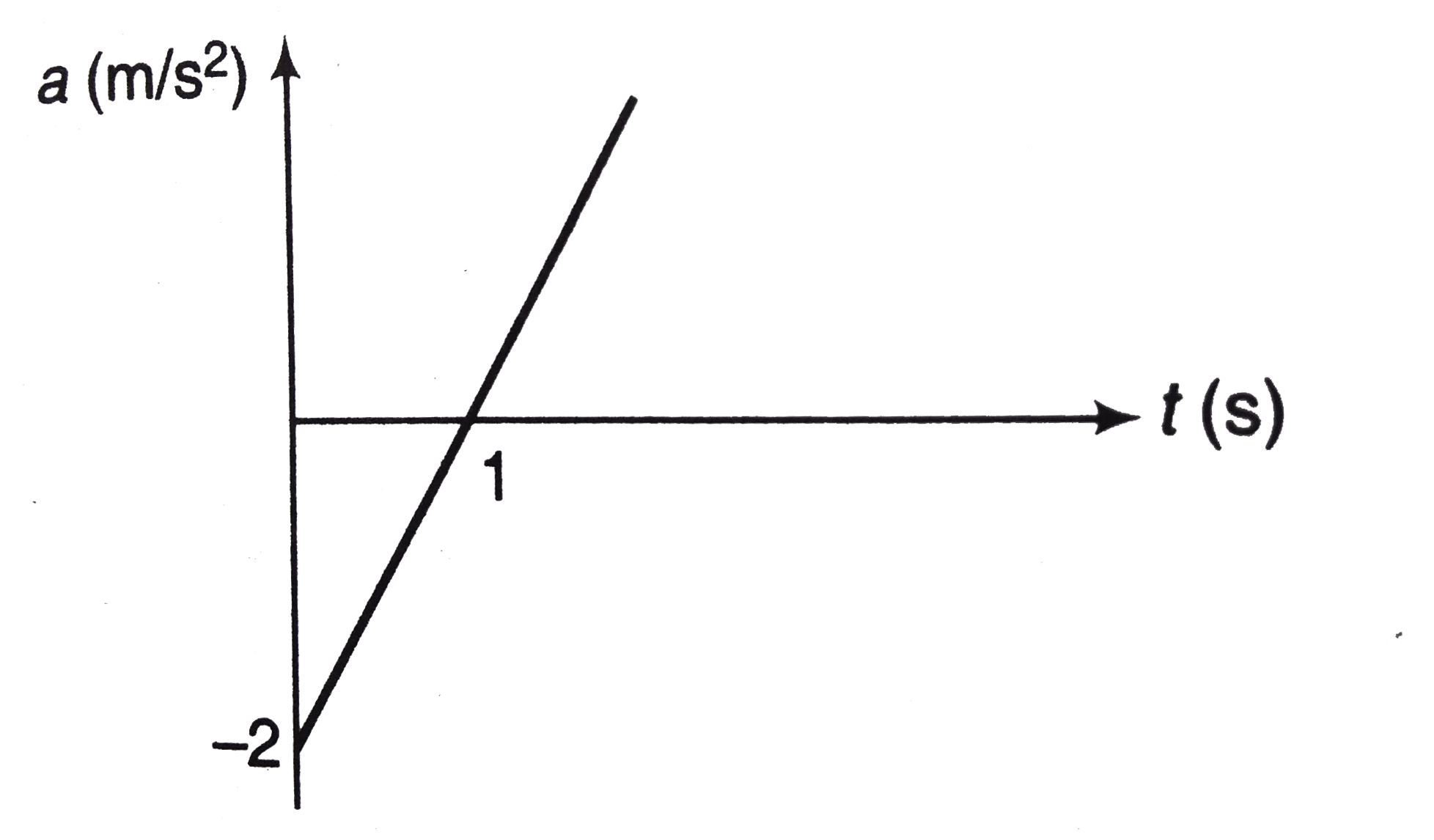The acceleration of a particle is given by a (t)=(3.00 m/s2−(2.00ms3))t. (a) Find the initial speed v0 such that the particle will have the same x -coordinate at t =5.00 as it had at t=0. (b)What will be the velocity at t =5.00s?
To solve the problem step by step, we will break it down into parts (a) and (b) as specified in the question.
Given:
The acceleration of the particle is given by:
a(t)=3.00m/s2−(2.00m/s3)t
Part (a): Find the initial speed v0 such that the particle will have the same x-coordinate at t=5.00 s as it had at t=0.
1. Understanding the Problem:
We need to find the initial velocity v0 such that the displacement at t=5 seconds is equal to the displacement at t=0 seconds.
2. Finding Velocity:
We know that acceleration a(t) is the derivative of velocity v(t):
a(t)=dvdt
Therefore, we can express the change in velocity as:
dv=a(t)dt
Integrating both sides gives:
v(t)=∫a(t)dt+C
where C is the constant of integration (initial velocity v0).
3. Integrating the Acceleration:
Substitute a(t):
v(t)=∫(3−2t)dt+v0
v(t)=3t−t2+v0
4. Finding Displacement:
The displacement s(t) is given by:
s(t)=∫v(t)dt
Substitute v(t):
s(t)=∫(3t−t2+v0)dt
s(t)=3t22−t33+v0t+C0
where C0 is the constant of integration (initial displacement).
5. Evaluating Displacement at t=0:
At t=0:
s(0)=0+0+0+C0=C0
So, s(0)=s0.
6. Evaluating Displacement at t=5:
At t=5:
s(5)=3(52)2−(53)3+v0(5)+s0
s(5)=3⋅252−1253+5v0+s0
s(5)=752−1253+5v0+s0
7. Setting s(5)=s(0):
Since s(5)=s(0):
752−1253+5v0+s0=s0
This simplifies to:
752−1253+5v0=0
8. Solving for v0:
Rearranging gives:
5v0=1253−752
Finding a common denominator (6):
5v0=2506−2256
5v0=256
v0=2530=56≈0.833m/s
Part (b): What will be the velocity at t=5.00 s?
1. Using the Velocity Equation:
We already have:
v(t)=3t−t2+v0
Substitute v0=0.833 and t=5:
v(5)=3(5)−(52)+0.833
v(5)=15−25+0.833
v(5)=−10+0.833
v(5)=−9.167m/s
Final Answers:
- (a) The initial speed v0 is approximately 0.833m/s.
- (b) The velocity at t=5.00s is approximately −9.167m/s.
The acceleration of the particle is given by:
a(t)=3.00m/s2−(2.00m/s3)t
We need to find the initial velocity v0 such that the displacement at t=5 seconds is equal to the displacement at t=0 seconds.
We know that acceleration a(t) is the derivative of velocity v(t):
a(t)=dvdt
Therefore, we can express the change in velocity as:
dv=a(t)dt
Integrating both sides gives:
v(t)=∫a(t)dt+C
where C is the constant of integration (initial velocity v0).
Substitute a(t):
v(t)=∫(3−2t)dt+v0
v(t)=3t−t2+v0
The displacement s(t) is given by:
s(t)=∫v(t)dt
Substitute v(t):
s(t)=∫(3t−t2+v0)dt
s(t)=3t22−t33+v0t+C0
where C0 is the constant of integration (initial displacement).
At t=0:
s(0)=0+0+0+C0=C0
So, s(0)=s0.
At t=5:
s(5)=3(52)2−(53)3+v0(5)+s0
s(5)=3⋅252−1253+5v0+s0
s(5)=752−1253+5v0+s0
Since s(5)=s(0):
752−1253+5v0+s0=s0
This simplifies to:
752−1253+5v0=0
Rearranging gives:
5v0=1253−752
Finding a common denominator (6):
5v0=2506−2256
5v0=256
v0=2530=56≈0.833m/s
We already have:
v(t)=3t−t2+v0
Substitute v0=0.833 and t=5:
v(5)=3(5)−(52)+0.833
v(5)=15−25+0.833
v(5)=−10+0.833
v(5)=−9.167m/s
- (a) The initial speed v0 is approximately 0.833m/s.
- (b) The velocity at t=5.00s is approximately −9.167m/s.
Topper's Solved these Questions
- BOOK - AAKASH SERIESCHAPTER - MOTION IN A STRAIGHT LINE EXERCISE - Question for descriptiv Answers7videos
MOTION IN A STRAIGHT LINE
- BOOK - AAKASH SERIESCHAPTER - MOTION IN A STRAIGHT LINE EXERCISE - Short answer type question16videos
MOTION IN A STRAIGHT LINE
- BOOK - AAKASH SERIESCHAPTER - MOTION IN A STRAIGHT LINE EXERCISE - Numerical exercise(LEVEL-1)22videos
MOTION IN A STRAIGHT LINE
- BOOK - AAKASH SERIESCHAPTER - MOTION IN A PLANEEXERCISE - QUESTION FOR DESCRIPTIVE ANSWER7videos
MOTION IN A PLANE
- BOOK - AAKASH SERIESCHAPTER - MOVING CHARGES AND MAGNETISMEXERCISE - EXERCISE-III49videos
MOVING CHARGES AND MAGNETISM
Similar Questions
The velocity of a particle is given by v=(2t2−3t+10)ms−1. Find the instantaneous acceleration at t = 5 s.
View SolutionThe distance travelled by a particle in time t is given by s=(2.5ms2)t2. Find a. the average speed of the particle during the time 0 to 5.0 s, and b. the instantaneous speed ast t=5.0 is
View SolutionThe acceleration of paticle varies with time as :
a(t)=3t2+4
If the initial velocity of particle is 2m/s, find the velocity of particle at t=3sec.View SolutionThe velocity time relation of a particle is given by v =(3t2−2t−1)m/s Calculate the position and acceleration of the particle when velocity of the particle is zero . Given the initial position of the particle is 5m .
View SolutionAcceleration of a particle at any time t is →a=(2tˆi+3t2ˆj)m/s2.If initially particle is at rest, find the velocity of the particle at time t=2s
View SolutionVelocity of a particle is given as v=(2t2−3)m/s. The acceleration of particle at t = 3s will be :
View SolutionIf velocity of a particle is given by v=(2t+3)m/s. Then average velocity in interval 0≤t≤1 s is :
View SolutionThe acceleration of particle varies with time as shown.

(a) Find an expression for velocity in terms of t.
(b) Calculate the displacement of the particle in the interval from t=2s to t=4s. Assume that v=0 at t=0.View SolutionThe position of a particle is given by the equation f(t)=t3−6t2+9t where t is measured in second and s in meter. Find the acceleration at time t. What is the acceleration at 4 s?
View SolutionAcceleration of a particle is given by
a=3t2+2t+1
Where t is time . Find
(i) its velocity at time t assuming velocity to be 10 m/s at t = 0.
(ii) its position at time t assuming that the particle is at origin at t = 0.
(iii) What is the average speed of the particle in the duration t = 0 to t = 1s?
(iv) What is the average acceleration of the particle in the duration t = 0 to t = 1s?View Solution

